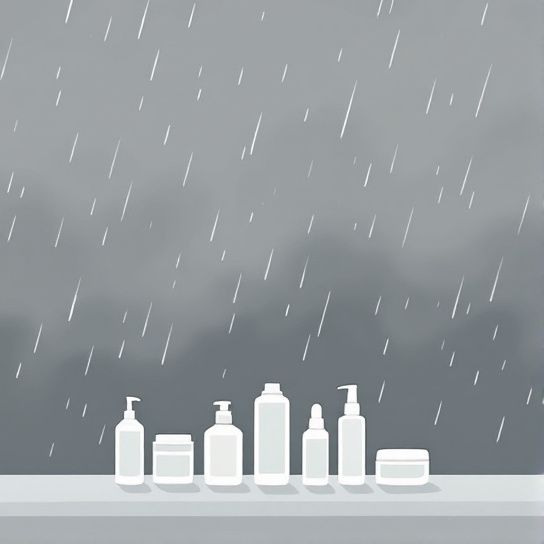Ah, summer storms. They come barreling in with their booming thunder and spectacular lightning displays, leaving behind a wake of humidity and that unique fresh-earth scent. But let’s have a real chat here – those dramatic shifts can throw more than just your picnic plans into turmoil. If you’ve ever noticed your skin throwing a bit of a hissy fit during these seasonal storms, you’re definitely not alone. Many people deal with what some might call “climate acne” – those unwelcome flare-ups aligned with stormy episodes. It’s frustrating and can leave you asking, “Why now?”
Whether you’re dealing with an intense breakout or minor climate acne irritation, understanding how summer storms affect your skin is crucial. Picture this: the skies darken, rain pounds down, and the storm leaves behind a sticky cloak of humidity that lingers like an unwelcome guest. We’re going to break down why your skin reacts the way it does when summer storms roll through, and more importantly, how you can soothe it. Because let’s face it, nobody wants their complexion mirrored after storm clouds.
What’s Up with Stormy Skin?
Imagine this: it’s a bright and sunny day, and then seemingly out of nowhere, the sky turns a moody grey, and a summer storm’s got you re-evaluating your choice of outdoor seating. But surprise! Your skin’s already on the scene, picking up cues from the weather changes faster than you can say ‘lightning bolt’. The increase in humidity levels swings your skin’s oil production into overdrive. Naturally oily skin can become a veritable slip-slide, while dry types might start to feel clogged and perhaps unusually shiny. This oiliness provides a playground for acne-causing bacteria. Bam! That’s how climate acne sneaks in.
The Humidity-Heat Trap
Humidity is the double-agent here, my friend. On the one hand, it locks in moisture – potentially a good thing. But, coupled with sweat, it also traps dead skin cells and dirt in your pores. Not the skin superhero you were hoping for, right? Consider climate acne the not-so-subtle spoiler of stormy days – humidity sends oil production soaring high, leading to congested skin, and gets those little spot-causing nasties breeding at full speed.
Getting a Grip on Summer Storm Skin Woes

Let’s move beyond the iconic splash banners and dive into what you can realistically do to look after that lovely face of yours during a seasonal storm skirmish. Here’s how you can play an active role in weatherproofing your complexion during these flashy interruptions.
Step 1: Keep it Light but Effective
First up – and I can’t stress this enough – resist the temptation to pile on heavier skincare products. Use lightweight moisturizers. Products labeled “non-comedogenic” and “oil-free” are your new best buddies. These will hydrate without risking additional clogging. Alternatively, gel-based moisturizers are heaven-sent in damp climates. They’re like giving your skin a big, refreshing gulp of water without the residual greasiness.
Step 2: Gentle Yet Thorough Cleaning
When it rains, it pours, and when it’s humid, your skin pours – quite literally. Sweat trapped underneath layers of moisture can cause untimely outbreaks. Gently cleanse your face morning and night to remove dirt and oil. A foaming or gel cleanser formulated for acne-prone skin can be really cleansing without overly stripping it.
- Morning: Splash some cold water – it tightens the pores and energizes the skin.
- Night: After cleansing, a little micellar water action can catch lingering debris. You’ll be surprised what sticks around.
Step 3: Exfoliate, but Don’t Overdo It

Exfoliation seems like every skin-woe’s knight in shining armor. While it’s a champ at removing dead skin cells and reducing excess oil build-up, be cautious. Over-exfoliation can backfire, causing more breakouts and irritation. Products with salicylic acid are usually gentle enough to keep skin balanced if used 1-2 times a week. Consider exfoliating at night – trust me on this one, your face will thank you.
Step 4: Calm, Not Complicate
Masks aren’t just for Halloween or K-dramas. Love clay-based masks during humid storms; they’re wizards at controlling breakouts and pulling impurities out from your pores. These masks offer a moment of serenity for your skin amidst the climate chaos.
Step 5: Don’t Dismiss Your Sunscreen
Throwback to that critical summer storm complexity: changing clouds means unpredictably intense sun rays dropping in through the haze post-storm. An SPF of at least 30 is essential every single day. Rain or shine, this is a step you don’t want to skimp on. Powder-based sunblocks can help dodge that extra shine during particularly sweaty spells.
Nutrition and Lifestyle Considerations
Weather-wise skincare isn’t solely about products. It’s about the equation – skin care practices plus lifestyle tweaks make the difference:

- Hydration Isn’t Just Surface Level: Drink water. Yes, you’ve heard it before, but it bears reiterating. Staying hydrated can curtail oil production and reduce acne severity.
- Flexitize Your Diet Accordingly: Superfoods that battle those imperfection-bringers include omega-3-rich fish, leafy veggies full of antioxidants, and zinc-packed goodies like nuts and seeds. They’re supportive allies in inflamed skin reduction.
- Routine the Right Way: Routine activities impact your climate acne. Sleeping with residues on exposes skin to bacterial interruptions; it gets imprisoned under the mask of humidity. Clean pillowcases shouldn’t be underestimated either.
Embrace the Process
Remember this isn’t about chasing perfect skin. Healthy, balanced skin at its best adapts calmly with those finger-snap storm transformations. Introducing slight modifications when storm season looms builds resilience against climate acne and helps define what feels empowered rather than reactive.
So, the next time you hear the clouds rumbling in the distance, take a moment – a deep breath after that flash of lightning. While mother nature goes through her mid-summer performance art, you now have your own rituals to keep acne from raining on your parade. Everyone’s skin is a bit different, so tailor these tips with patience while the summer rolls through its usual quarrels.
Skin is a dynamic canvas reflecting our environment more than we often credit. Now that you’re equipped with your summer storm survival kit in the form of these tips, even the wildest weather changes – like relentless humidity – can feel a little more manageable. Trust the process, and love the skin through life, one storm at a time!
Frequently Asked Questions
How does hot and humid weather affect acne?
In hot and humid climates, increased sweat production can lead to clogged pores. The combination of sweat, oil, and bacteria creates an environment conducive to acne, particularly on the face, back, and chest. Excess moisture in the air and overexposure to the sun can also irritate the skin and worsen acne[1][4].
What impact does cold and dry weather have on acne?
Cold and dry climates can cause the skin to become dry and flaky, triggering the skin to produce more oil to compensate. This increased oil production can clog pores and lead to acne. Additionally, dry skin is more prone to flaking, which can trap dead skin cells and oil in the pores, exacerbating acne[1][3].
How do seasonal changes influence acne?
Seasonal changes can significantly impact acne. During winter, the lack of sunlight reduces vitamin D production, which has anti-inflammatory properties that help prevent acne. In contrast, summer’s increased sun exposure can lead to sunburn and irritation, worsening acne for some individuals. Understanding these seasonal variations can help in managing acne effectively[1][3].
What are some tips to prevent and treat climate-related acne?
To prevent and treat climate-related acne, it is important to adjust your skincare routine according to the climate. In hot and humid weather, use non-comedogenic sunscreen and gentle cleansers. In cold and dry weather, avoid hot showers, use gentle and hydrating cleansers, and moisturize regularly to prevent dryness and flakiness. Using climate-smart skincare products can also help the skin adjust to different environmental conditions[1][3][5].
References










